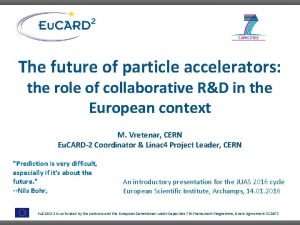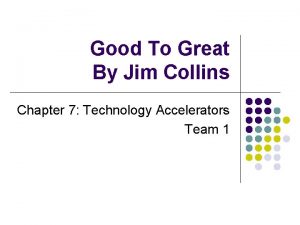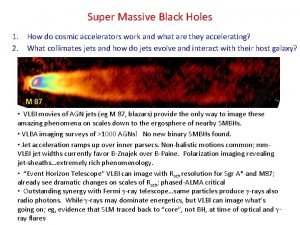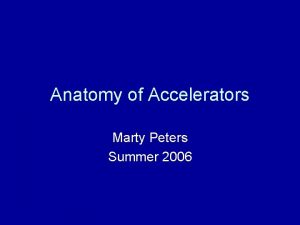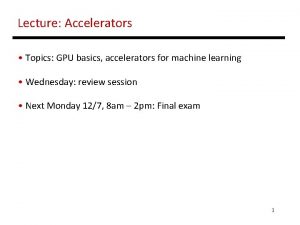Anatomy of Accelerators Marty Peters Summer 2006 Linear













- Slides: 13

Anatomy of Accelerators Marty Peters Summer 2006

Linear Accelerators Electrodes are separated by small gaps and placed along a straight line. When particles move inside the field-free region of a given electrode, the direction of the accelerating electric field is reversed so that particles are always accelerated in the gaps between the electrodes. Illustration: Fredrik Stendahl t The 3 km long linear accelerator at Stanford. Photo: Stanford Linear Accelerator Center Source: http: //nobelprize. org/physics

Fermi National Accelerator Laboratory • Fermilab is home to the Tevatron, the world's highestenergy particle accelerator. Four miles in circumference, the Tevatron is housed in a tunnel about 30 feet below the big ring you see in this aerial view of the laboratory. A series of accelerators is used to send particles racing around the Tevatron at 99. 9999 percent of the speed of light in a vacuum. The particles complete the four -mile course nearly 50 thousand times a second. Source: www. fnal. gov

Computer view of protonantiproton collision. Two kinds of particles, protons and antiprotons, are sent around the ring in opposite directions. At two points in the ring, streams of these particles (called "beams") are steered right into each other, and collisions, at the rate of almost two million each second, are watched. Source: www. fnal. gov, http: //quarknet. fnal. gov

Antiproton Production • To make antiprotons, protons are accelerated to 120 billion electron-volts (120 Ge. V) and strike them against a solid target. Out of the target come both antiprotons and secondary protons. There about five secondary protons to each antiproton. • The system gets about 50 million antiprotons per shot off the target. Source: www. highbeam. com

Antiprotons were produced by operating the Main Ring at 120 Ge. V. The antiprotons were collected in a Debuncher ring before they were transferred to the Accumulator where stochastic cooling was applied. After cooling, the antiprotons were injected into the Main Ring and Tevatron for acceleration to 1 Te. V. With the recent extension of the Fermilab complex, the main Ring has been replaced by a new rapid cycling 120 Ge. V synchrotron, the Main Injector. In the same tunnel, an 8 Ge. V storage ring, the Recycler, has been constructed using permanent magnets. The Recycler acts as a repository for cooled antiprotons, thus permitting a high rate of cooling in the Accumulator which works best with low currents, to be maintained. The Recycler also receives antiprotons left over and decelerated after completion of a storage in the Tevatron. Stochastic cooling, initially installed in the Recycler, will be enhanced by the addition of electron cooling in the near future. Source: /nobelprize. org/physics

In a single head-on collision between proton and antiproton in the Tevatron, hundreds of new particles are usually created. According to Einstein’s formula E=mc 2, the maximum mass that can be converted from kinetic energy corresponds to the mass of about 2000 protons, if all the kinetic energy of the proton and antiproton in a single collision were to be converted to mass. Source: /nobelprize. org/physics

DZero Collider Detector • Fermilab's two collider detectors--CDF and DZero--are about four stories high and weigh some 5, 000 tons (10 million pounds) each. The particle collisions occur in the center of the detectors, which are crammed with electronic instrumentation. Source: www. fnal. gov

Source: http: //quarknet. fnal. gov

Source: http: //quarknet. fnal. gov

CDF Collider Detector • Each detector has about one million individual pathways for recording electronic data generated by the particle collisions. The signals are carried over nearly a thousand miles of wires and cables-each one connected by hand tested individually. Source: www. fnal. gov

Schematic of Modern Detector Source: particleadventure. org

Interaction of Particles with Detector Components Source: particleadventure. org
 The long-term future of particle accelerators
The long-term future of particle accelerators Accelerators computer architecture
Accelerators computer architecture Slidetodoc
Slidetodoc Good to great technology accelerators
Good to great technology accelerators Good to great chapter 7 summary
Good to great chapter 7 summary Cosmic super accelerators
Cosmic super accelerators Set current query acceleration
Set current query acceleration Dilbert product management
Dilbert product management Maggie strus
Maggie strus Shiloh main characters
Shiloh main characters Marty kay
Marty kay Marty hall java
Marty hall java We are many parts marty haugen
We are many parts marty haugen Marty
Marty
